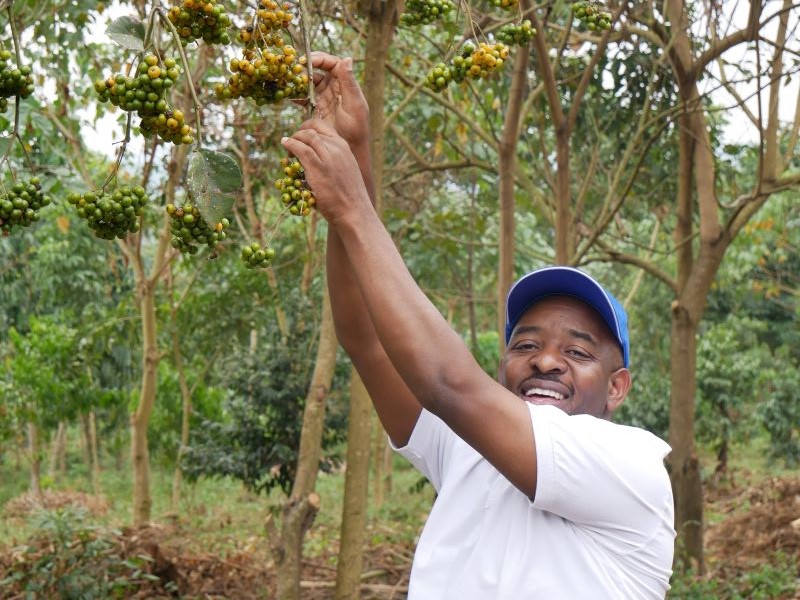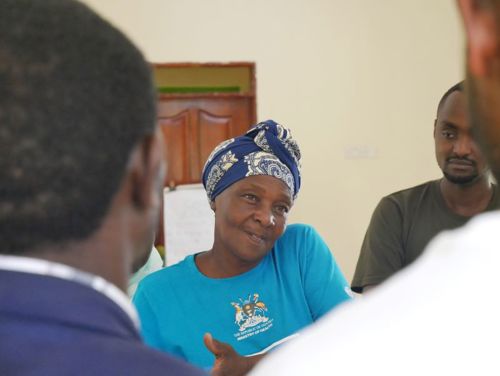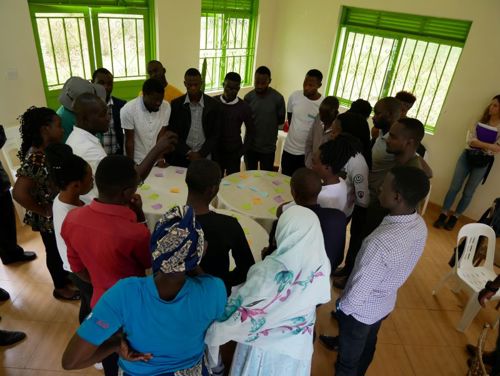Native plants: Food for people and biodiversity

Fruit collection: Godfrey Ruyonga collecting fruits from a restored area in Lwamunda. Credit - Alex Hudson, BGCI.
Native plants: Making food for people and biodiversity
Mulilira , Lukindu , Doodo , Mutere , Ensugga, Tokekulu, Kitugunda, Muziru, Nagomola, Mukoge, Jjobyo , Kiyindiru, and Amovongo . The Lugandan names of 13 of Uganda’s edible native plants. Dragon’s blood tree (Harungana madagascariensis), wild date palm (Phoenix reclinata), Thunberg’s amaranthus (Amaranthus thunbergia), jute (Corchorus olitorius), black nightshade (Solanum nigrum), wild custard apple (Annona senegalensis), triangle flowered wild medlar (Vangueria apiculate), small-fruited African plum (Pseudospondias macrocarpa), African calabash nutmeg (Monodora myristica), tamarind (Tamarindus indica), spiderwisp (Cleome gynandra), cowpea (Vigna unguiculata), and bungo fruit (Saba comorensis) – their English and Latin names, to bring them closer to home? Perhaps not. Even names that ring a bell may not actually be in the same plant groups as they seem, as is often the case with common names – an important reason the binomial or ‘Latin’ system, Carl Linnaeus started in the 19th century, is so great for providing so much information with so few words.
But taxonomic wonder is not the story here. These are the 13 plant species selected in our project as having greatest potential for success in development strategies that could provide benefits to Ugandan people and nature.
An incredible 7,000+ plant species have been recorded as edible by someone, somewhere on the planet. From roots and tubers to leaves, fruits and seeds, we gobble them down. Yet, just nine species account for 66% of the world’s crop production. This is a result of intensive monocultures – a ‘success’ of the past century, although also providing unwanted side effects of soil depletion and erosion, pesticide and inorganic fertiliser pollution, and biodiversity depletion. Meanwhile, thousands of edible plants remain underutilised and unknown by the majority, like the EU, US, and the ‘developed’ world.
Some species, like Ethiopian tef (Eragrostis tef), African baobab (Adansonia digitata), or India’s ‘miraculous’ moringa (Moringa oleifera), do break through; but why and how did they become better known? And how might we replicate their story for many others, before they are lost from our memories and landscapes?
"Strategies focus on the national pride for Ugandan heritage, the economic and agronomic benefits, and the health benefits they offer."
Understanding their value
A lot is already known about useful African plants. Many are multipurpose, providing not just nutrition but medicines, wood to burn, dyes, and timbers to work. But what do people think of their importance; how much do they like using them; how do they feel about losing them; and how much would they be willing to do to support keeping them around and why? Answers to these fundamental questions can be harder to understand and build into development plans.
Tooro Botanical Gardens, alongside Entebbe Botanical Gardens and GrassRoots Ltd, set out to do that in rural areas and towns and cities of Uganda armed with the names and information of 34 target edible native species.
Farmers told the team they boil, steam, toast, and eat raw produce from these species. But they also said they are becoming less available as people see issues with spoilage, lack of preparation options, and yields are reduced by herbicides used on farmland. Exotic species are adopted more, with exhausted soils acknowledged as a common and general problem in the landscape.
In the markets, people have memories of species being ‘used way back in the village’ they grew up in and some look for them when they are available, like the wild custard apple (Annona senegalensis). However, some stallholders also felt low demand and perishability mean they are no longer sold despite recognition of their importance to people’s health.
With mixed responses from farmers, sellers, and consumers, good marketing strategies are needed to support new market developments for any produce that comes from these species. GrassRoots Ltd recommend that strategies focus on the national pride for Ugandan heritage, the economic and agronomic benefits that growing these species provides and, of course, the health benefits they offer.

Superfoods
Superfoods, like moringa, are considered ‘miraculous’ because they are packed with nutrients. This characteristic has boosted their value and the markets for their consumption at a global level. For this reason, Makerere University trained 31 local community members to identify and collect fruits of the target species, and deliver them to the university. There, the researchers examined them to discover if any could be the next superfood. Many macro- and micronutrients were assessed, and then the four micronutrients that are particularly important to health issues in Uganda focused on:
- Vitamin A – impacting vision and organ function,
- Iron – essential for haemoglobin which carries oxygen around the body. A lack of which has been linked to many childhood and maternal diseases,
- Calcium – because of its importance through pregnancy and in development of bones and teeth, and
- Selenium – because it boosts immunity and so could help protect against infections, particularly in those with poorly functioning immune systems, like patients with HIV/ AIDS.

Species for the future
To help pick which species are best suited to future development and promotion, the team used the results from the above activities to score each species. The five factors were:
1) levels of important nutrients contained,
2) their marketability in Uganda,
3) rural communities’ strength of feeling towards them,
4) how easy they are to propagate, and
5) what quantity of raw materials are known to be available.
These scores helped determine the list mentioned at the start.
In the next few months, the team in Makerere University will develop some new products - be they jams, powders, yoghurts, or anything else – that will help to reduce their perishability and provide access to bigger urban markets. These results will be the groundwork for promoting these native species more widely.
As markets develop and grow, these native plant species can provide rural communities with new earning opportunities. Local knowledge and pride, supported by science, could help the transition away from exotic monocultures towards multi-species native agroforestry; a small and innovative step in a biodiversity friendly direction.
Written by Alex Hudson. For more information on this Darwin Initiative Innovation project DARNV005, led by Botanic Gardens Conservation International (BGCI), please click here.

 Back
Back